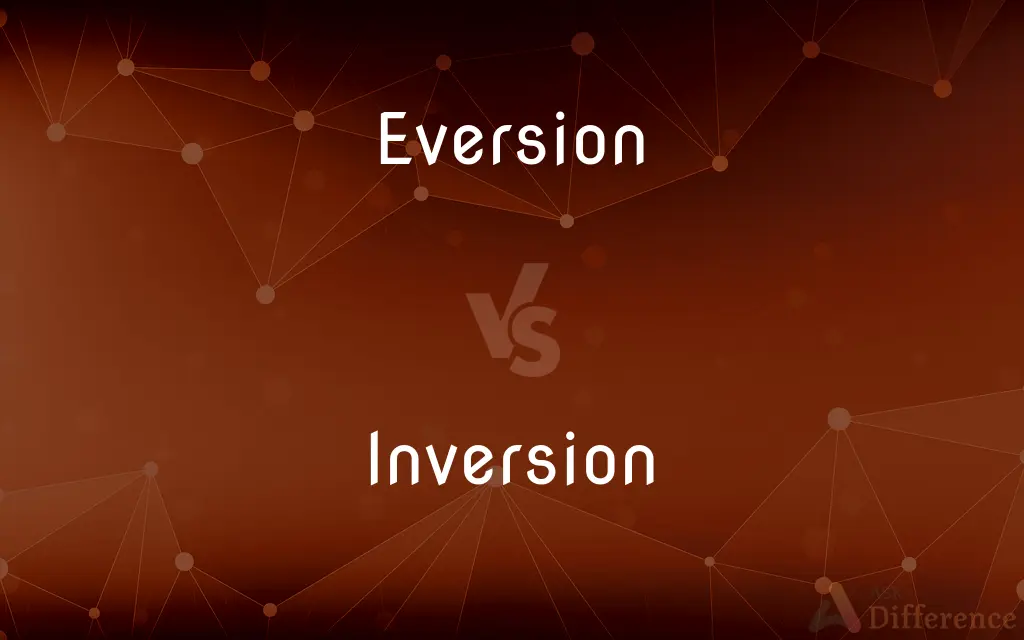Eversion vs. Inversion — What's the Difference?
By Urooj Arif & Fiza Rafique — Updated on March 26, 2024
Eversion involves turning outward, while inversion refers to turning inward.

Difference Between Eversion and Inversion
Table of Contents
ADVERTISEMENT
Key Differences
Eversion and inversion are terms often used to describe movements or orientations, especially in anatomy and physical activities. Eversion pertains to the movement of turning a part of the body outward, away from the midline of the body. For example, everting the foot involves rotating the sole outwards, away from the central axis of the body. In contrast, inversion is the process of turning inward, towards the midline of the body. When applied to the foot, inversion means rotating the sole inwards, making it face more towards the body's central axis.
In the context of physical fitness or rehabilitation, these movements are significant for training balance, stability, and flexibility. Eversion exercises might be employed to strengthen the muscles and ligaments on the outer part of the ankle and foot, aiding in the prevention of injuries that occur when the foot rolls outward. Meanwhile, inversion exercises target the inner aspects of the ankle and foot, helping to prevent inward rolling of the foot, which is a common cause of ankle sprains.
Eversion and inversion are not only limited to feet and ankles. These terms can be applied to other parts of the body or objects that can undergo similar outward or inward rotations. However, they are most commonly associated with the movements of the foot and ankle due to the common injuries and conditions related to these specific movements.
The understanding of eversion and inversion is crucial in fields like orthopedics, physical therapy, and sports medicine. Correctly identifying and strengthening the muscles involved in these movements can significantly reduce the risk of injury and improve overall mobility and performance. For instance, athletes are often trained to enhance their eversion and inversion capabilities to better stabilize their ankles during dynamic movements.
The balance between eversion and inversion movements is essential for maintaining proper posture and alignment during standing, walking, and running. Imbalances or weaknesses in these movements can lead to a chain reaction of postural issues and injuries, highlighting the importance of balanced training and rehabilitation strategies for these movements.
ADVERTISEMENT
Comparison Chart
Definition
Turning outward, away from the midline of the body.
Turning inward, towards the midline of the body.
Associated With
Outer part of the ankle and foot.
Inner part of the ankle and foot.
Significance
Prevents injuries caused by the foot rolling outward.
Helps in preventing the inward rolling of the foot, leading to sprains.
Applications
Used in balance and stability training, particularly for the outer ankle.
Important in strengthening inner ankle muscles for stability and support.
Common Injuries
Less common compared to inversion injuries but can lead to sprains.
Common cause of ankle sprains and related injuries.
Compare with Definitions
Eversion
Rehabilitation focus.
After an ankle sprain, eversion exercises help restore range of motion.
Inversion
Targeted by certain workouts.
Inversion exercises using resistance bands strengthen the inner ankle.
Eversion
Balance and posture.
Proper eversion is crucial for maintaining balance in dynamic movements.
Inversion
Critical in rehabilitation.
Post-injury, inversion exercises are essential for recovery and prevention.
Eversion
Strengthening exercises.
Lateral band walks target muscles involved in foot eversion.
Inversion
Common injury mechanism.
Ankle sprains often occur due to excessive inversion under stress.
Eversion
Prevention of outward rolling injuries.
Strong evertor muscles can prevent ankle injuries during sports.
Inversion
Inward rotation.
Inversion of the foot is a natural motion during walking and running.
Eversion
Outward rotation.
Eversion of the foot increases its flexibility and lateral stability.
Inversion
Affects alignment and stability.
Adequate inversion strength supports proper foot alignment during activities.
Eversion
The action of turning a structure or organ outwards or inside out
Eversion of the upper lid revealed two lesions
Inversion
The action of inverting something or the state of being inverted
The inversion of the normal domestic arrangement
An inversion of traditional customer–supplier relationships
Eversion
The act of turning inside out.
Inversion
A reversal of the normal decrease of air temperature with altitude, or of water temperature with depth.
Eversion
The condition of being turned inside out.
Inversion
The process of finding a quantity, function, etc. from a given one such that the product of the two under a particular operation is the identity.
Eversion
The condition of being turned outward.
Inversion
The action or practice of relocating a multinational company's legal residence to a jurisdiction where taxes are levied at a lower rate
Since the company maintains a franchisee model, it is a viable target for inversion
Administration officials admit that their new effort to deter corporate inversions won't actually stop the practice
Eversion
An act of turning inside out.
Inversion
The act of inverting.
Eversion
The state of being turned inside out.
Inversion
The state of being inverted.
Eversion
(medicine) The condition of being turned outward.
Inversion
An interchange of position of adjacent objects in a sequence, especially a change in normal word order, such as the placement of a verb before its subject.
Eversion
The act of eversing; destruction.
Inversion
A rearrangement of tones in which the upper and lower voices of a melody are transposed, as in counterpoint.
Eversion
The state of being turned back or outward; as, eversion of eyelids; ectropium.
Inversion
A rearrangement of tones in which each interval in a single melody is applied in the opposite direction.
Eversion
The position of being turned outward;
The eversion of the foot
Inversion
An arrangement of the tones of a chord such that the root is not the lowest pitch, as in the rearrangement of the C-major triad CEG to EGC.
Eversion
The act of turning inside out
Inversion
(Chemistry) Conversion of a substance in which the direction of optical rotation is reversed, from the dextrorotatory to the levorotatory or from the levorotatory to the dextrorotatory form.
Inversion
(Meteorology) An atmospheric condition in which the air temperature rises with increasing altitude, holding surface air down and preventing dispersion of pollutants.
Inversion
(Genetics) A chromosomal rearrangement in which a segment of the chromosome breaks off and reattaches in the reverse direction.
Inversion
The action of inverting.
Inversion
The act of being in an inverted state; being upside down, inside out, or in a reverse sequence.
Inversion
(music) The reversal of an interval; the move of one pitch in an interval up or down an octave.
Inversion
(music) The position of a chord which has a note other than the root as its bass note.
Inversion
(music) The flipping of a melody or contrapuntal line so that high notes become low and vice versa; the reversal of a pitch contour.
Inversion
(genetics) A segment of DNA in the context of a chromosome that is reversed in orientation relative to a reference karyotype or genome.
Inversion
(meteorology) A situation where air temperature increases with altitude (the ground being colder than the surrounding air).
Temperature inversion
Inversion
A section of a roller coaster where passengers are temporarily turned upside down.
Inversion
(grammar) deviation from standard word order by putting the predicate before the subject. It takes place in questions with auxiliary verbs and in normal, affirmative clauses beginning with a negative particle, for the purpose of emphasis.
Inversion
(algebra) An operation on a group, analogous to negation.
Inversion
, particularly in early psychoanalysis.
Inversion
The act of inverting, or turning over or backward, or the state of being inverted.
Inversion
A change by inverted order; a reversed position or arrangement of things; transposition.
It is just the inversion of an act of Parliament; your lordship first signed it, and then it was passed among the Lords and Commons.
Inversion
A movement in tactics by which the order of companies in line is inverted, the right being on the left, the left on the right, and so on.
Inversion
A change in the order of the terms of a proportion, so that the second takes the place of the first, and the fourth of the third.
Inversion
A peculiar method of transformation, in which a figure is replaced by its inverse figure. Propositions that are true for the original figure thus furnish new propositions that are true in the inverse figure. See Inverse figures, under Inverse.
Inversion
A change of the usual order of words or phrases; as, "of all vices, impurity is one of the most detestable," instead of, "impurity is one of the most detestable of all vices."
Inversion
A method of reasoning in which the orator shows that arguments advanced by his adversary in opposition to him are really favorable to his cause.
Inversion
Said of intervals, when the lower tone is placed an octave higher, so that fifths become fourths, thirds sixths, etc.
Inversion
The folding back of strata upon themselves, as by upheaval, in such a manner that the order of succession appears to be reversed.
Inversion
The act or process by which cane sugar (sucrose), under the action of heat and acids or enzymes (as diastase), is broken or split up into grape sugar (dextrose), and fruit sugar (levulose); also, less properly, the process by which starch is converted into grape sugar (dextrose).
Inversion
A reversal of the usual temperature gradient of the atmosphere, in which the temperature increases with increased altitude, rather than falling. Called also temperature inversion.
Inversion
The conversion of direct current into alternating current; the inverse of rectification. See inverted rectifier.
Inversion
A portion of the genome in which the DNA has been turned around, and runs in a direction opposite to its normal direction, and consequently the genes are present in the reverse of their usual order.
Inversion
The layer of air near the earth is cooler than an overlying layer
Inversion
Abnormal condition in which an organ is turned inward or inside out (as when the upper part of the uterus is pulled into the cervical canal after childbirth)
Inversion
A chemical process in which the direction of optical rotation of a substance is reversed from dextrorotatory to levorotary or vice versa
Inversion
(genetics) a kind of mutation in which the order of the genes in a section of a chromosome is reversed
Inversion
The reversal of the normal order of words
Inversion
(counterpoint) a variation of a melody or part in which ll ascending intervals are replaced by descending intervals and vice versa
Inversion
Turning upside down; setting on end
Inversion
The act of turning inside out
Common Curiosities
What causes inversion ankle sprains?
Inversion ankle sprains occur when the foot rolls inward excessively, stretching or tearing the ligaments on the outside of the ankle.
Can eversion movements help prevent ankle injuries?
Yes, strengthening the muscles that control eversion can help prevent injuries by providing greater stability to the ankle.
Are inversion exercises important for everyone?
While especially crucial for athletes, inversion exercises benefit anyone looking to improve ankle stability and prevent sprains.
Are there any risks associated with eversion or inversion exercises?
Performing these exercises with improper form or excessive intensity can lead to strain. It’s important to start slowly and increase gradually.
How do eversion and inversion relate to balance?
Proper control and strength in both movements are essential for maintaining balance and preventing falls during various activities.
Can issues with eversion or inversion affect posture?
Yes, imbalances or weaknesses can lead to incorrect foot positioning, affecting overall posture and leading to further injuries.
How do physical therapists assess eversion and inversion?
Through physical examinations and specific tests to evaluate strength, flexibility, and range of motion in the ankle.
What role do eversion and inversion play in rehabilitation?
They are key focuses in rehabilitation programs for ankle injuries, aiming to restore strength, flexibility, and balance.
How often should one perform eversion and inversion exercises?
Frequency depends on individual goals and needs, but incorporating them into regular fitness routines can improve ankle health and stability.
What equipment is needed for these exercises?
Resistance bands, balance boards, and stability balls can be used, though many exercises require no equipment.
Do certain sports require stronger eversion or inversion?
Sports that involve rapid changes in direction, like soccer or basketball, benefit from strong control over these movements.
Is it possible to overtrain eversion or inversion?
Yes, overtraining can lead to muscle imbalances and strain, highlighting the need for a balanced approach to ankle conditioning.
How can one tell if they have a weakness in eversion or inversion?
Difficulty maintaining balance, frequent ankle sprains, or discomfort during these movements might indicate a weakness.
What are the long-term benefits of improving eversion and inversion?
Improved stability, reduced risk of ankle injuries, better posture, and enhanced performance in physical activities.
Can wearing certain types of shoes affect eversion and inversion?
Yes, shoes that lack proper support can impair these movements, leading to an increased risk of injury.
Share Your Discovery

Previous Comparison
Alabamian vs. Alabaman
Next Comparison
Architype vs. ArchetypeAuthor Spotlight
Written by
Urooj ArifUrooj is a skilled content writer at Ask Difference, known for her exceptional ability to simplify complex topics into engaging and informative content. With a passion for research and a flair for clear, concise writing, she consistently delivers articles that resonate with our diverse audience.
Co-written by
Fiza RafiqueFiza Rafique is a skilled content writer at AskDifference.com, where she meticulously refines and enhances written pieces. Drawing from her vast editorial expertise, Fiza ensures clarity, accuracy, and precision in every article. Passionate about language, she continually seeks to elevate the quality of content for readers worldwide.
















































